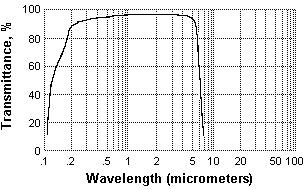|
Lithium Fluoride is used for windows, prisms, and lenses in the visible and infrared where desired transmission is in the 0.104μm - 7μm range. Modest precautions should be taken against moisture and high energy radiation damage. LiF is attacked by atmospheric moisture at 400 °C and softens at 600 °C. LiF is sensitive to thermal shock. Irradiation produces color centers. The material can be cleaved. Lithium fluoride is grown by vacuum Stockbarger technique in diameters of 115mm. Although the optical characteristics are good the structure is not perfect and cleavage is difficult. For good structure LiF is less commonly grown by the Kyropoulos method (air-grown) specifically for monochromator plates. Cleavage is (100) and less commonly (110). LiF is slightly plastic and can be bent into radius plates. |
||||||||||||||||||||||||||||||||||||||||||
|
||||||||||||||||||||||||||||||||||||||||||
Lithium Fluoride (LiF)

